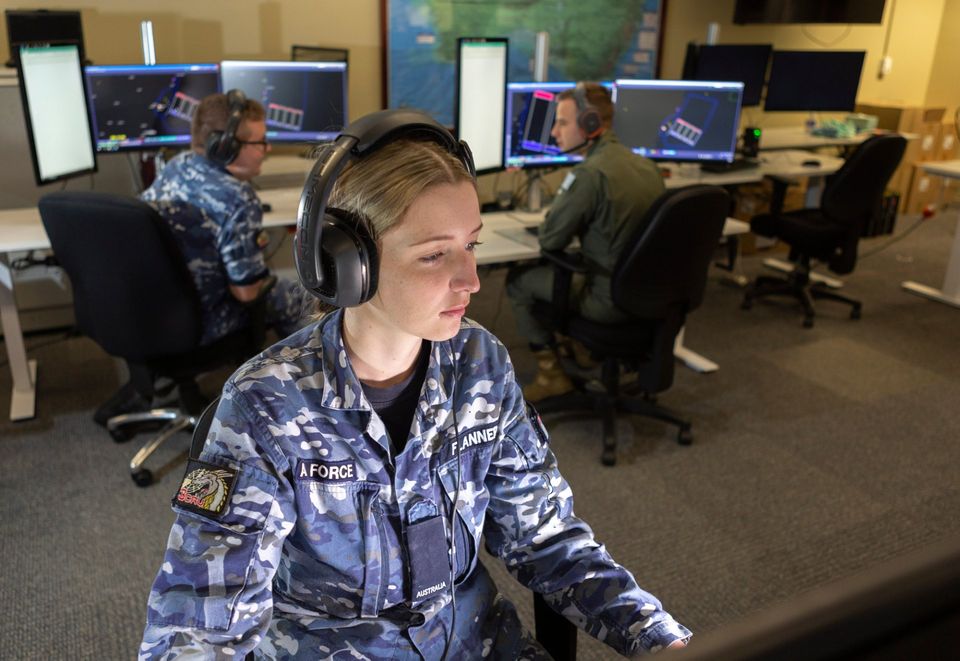Blog Layout
Unlocking the nation’s talent
By Professor Tanya Monro FAA FTSE FOSA FAIP Chief Defence Scientist
For Defence, the lack of women in STEM degrees and within the pipeline is a capability issue. A diverse and inclusive workforce is not only key to the nation’s prosperity, but its security. As one of the largest investors into R&D, and novel technology, it is crucial that the staffing of Defence reflects the society we want to build.

Defence has historically been regarded as a male domain, yet today there are 21 female Defence ministers across 159 countries. In Australia, we have a female Minister for Defence, a female Minister for Defence Industry and a female Chief Defence Scientist. A first for our nation.
While these achievements are to be celebrated, I look forward to the time when such appointments no longer make headlines.
It is clear to me that while we may have achieved a number of successes with female appointments to leadership roles – including 30% of all ASX200 board positions – we require fundamental social and cultural change to achieve true gender equity.
Nowhere is this more true than in science, technology, engineering and mathematics (STEM) fields.
Women comprise 46 per cent of the Australian working population, and only 16 per cent of the STEM workforce. Defence is actively working to bring more young women into its workforce.
At a time when 75 per cent of the fastest growing occupations require STEM skills and knowledge, women represent only 20 per cent of students completing a tertiary STEM education.
As Chief Defence Scientist, this is an issue that is particularly close to my heart. For Defence, it’s a capability issue.
An inclusive lens on STEM engagement is essential. We must ensure that we are accessing the best talent from all parts of our diverse Australian community. When I returned to work at four days a week after having my first child, a manager agreed to call it “full time”. It was not about the money, but the recognition that you can deliver results in a flexible way. This recognition gave me so much energy and made me want to give back.
Once we have a diverse and inclusive STEM workforce we will be able to fully unlock the talent of our nation.
In May 2020, Defence released More, together: Defence Science and Technology Strategy 2030. At the heart of this strategy sit three foundational pillars, with ‘Brilliant people, collaborative culture’ being one. This pillar is intended to support scaling up of the broader Defence science and technology program by developing a highly skilled and collaborative workforce.
To ensure Australia can meet the future Defence and national security challenges, it’s critical that we build a world-leading, STEM-capable workforce. This will only be achieved by increasing the depth and diversity of the talent pool, and increasing the participation rate of women is critical to achieving this.
Data from the Department of Industry, Science, Energy and Resources (DISER) suggest women are poorly represented in STEM. The reasons for this are many and complex. To attract and retain women we need to address factors such as unconscious bias and stereotyping, career insecurity, flexible work arrangements, and the lack of female role models. These areas have been demonstrated to greatly influence girls’ and women’s decisions to enter and remain in STEM education and careers.
Role models are particularly critical. We need our senior leaders to support the talent pipeline and celebrate women’s achievements.
I was 14 when a wonderful physics teacher inspired me. I came to realise that physics combined my love of maths with my drive to be creative and solve problems. However, I did not have a female lecturer or supervisor throughout my studies, and I know that was not unusual. While there are more female professors today, we need to progress to a point where this is the norm.
As a significant employer of STEM-skilled personnel, we in Defence recognise that we have a critical role to play in shaping the conversation and policy around STEM at a national level.
Defence has formed the Defence STEM Council with Senior Executives from the Defence Groups and Services and key stakeholders from DISER and the Department of Education, Skills and Employment, ensuring both a One Defence and broader whole of government approach. I have the privilege of chairing the Defence STEM council.
In 2019, we launched our strategic vision for our STEM workforce: “Moving towards a high-tech future for Defence”. Through this vision we hope to address some of the key challenges confronting our nation.
Although the participation rates of women in Defence STEM occupations have been slowly increasing, it is clear that we need a systematic and comprehensive approach to increasing the depth and diversity of the talent pool.
In February 2020, Defence was recognised for its commitment to gender equity, receiving the SAGE Bronze Award, recognising organisations that are committed to advancing the careers of women in Science, Technology, Engineering, Mathematics and Medicine (STEMM) disciplines. Defence has also recently become an organisational Champion of the Women in STEM Decadal Plan.
In Australia, there is a growing dependence on the STEM workforce to drive innovation and ensure we remain competitive in a tough global economy.
Unless we take action in the coming years, our demand for STEM talent will not be met.
A society which embraces research and science, and incorporates the best scientific knowledge into its defence arena and other public policies, is a society where everyone benefits.
Image © Commonwealth of Australia 2020

By Dr Saraid Billiards - CEO of the Association of Australian Medical Research Institutes.
•
March 27, 2023
If the health and medical research sector in Australia is to move forward, it must address gender equity, diversity, and inclusion- which means making the sector a safe and inclusive workspace for all.

By By Ben Kehoe
•
January 27, 2023
In 2016 I published a blog article titled Moonshots for Australia: 7 For Now. It’s one of many I have posted on business and innovation in Australia. In that book, I highlighted a number of Industries of the Future among a number of proposed Moonshots. I self-published a book, Innovation in Australia – Creating prosperity for future generations, in 2019, with a follow-up COVID edition in 2020. There is no doubt COVID is causing massive disruption. Prior to COVID, there was little conversation about National Sovereignty or supply chains. Even now, these topics are fading, and we remain preoccupied with productivity and jobs! My motivation for this writing has been the absence of a coherent narrative for Australia’s business future. Over the past six years, little has changed. The Australian ‘psyche’ regarding our political and business systems is programmed to avoid taking a long-term perspective. The short-term nature of Government (3 to 4-year terms), the short-term horizon of the business system (driven by shareholder value), the media culture (infotainment and ‘gotcha’ games), the general Australian population’s cynical perspective and a preoccupation with a lifestyle all create a malaise of strategic thinking and conversation. Ultimately, it leads to a leadership vacuum at all levels. In recent years we have seen the leadership of some of our significant institutions failing to live up to the most basic standards, with Royal Commissions, Inquiries and investigations consuming excessive time and resources. · Catholic Church and other religious bodies · Trade Unions · Banks (and businesses generally, take casinos, for example) · the Australian Defence Force · the Australian cricket teams · our elected representatives and the staff of Parliament House As they say, “A fish rots from the head!” At best, the leadership behaviour in those institutions could be described as unethical and, at worst….just bankrupt! In the last decade, politicians have led us through a game of “leadership by musical chairs” – although, for now, it has stabilised. However, there is still an absence of a coherent narrative about business and wealth creation. It is a challenge. One attempt to provide such a narrative has been the Intergenerational Reports produced by our federal Government every few years since 2002. The shortcomings of the latest Intergenerational Report Each Intergenerational Report examines the long-term sustainability of current government policies and how demographic, technological, and other structural trends may affect the economy and the budget over the next 40 years. The fifth and most recent Intergenerational Report released in 2021 (preceded by Reports in 2002, 2007, 2010 and 2015) provides a narrative about Australia’s future – in essence, it is an extension of the status quo. The Report also highlights three key insights: 1. First, our population is growing slower and ageing faster than expected. 2. The Australian economy will continue to grow, but slower than previously thought. 3. While Australia’s debt is sustainable and low by international standards, the ageing of our population will pressure revenue and expenditure. However, its release came and went with a whimper. The recent Summit on (what was it, Jobs and Skills and productivity?) also seems to have made the difference of a ‘snowflake’ in hell in terms of identifying our long-term challenges and growth industries. Let’s look back to see how we got here and what we can learn. Australia over the last 40 years During Australia’s last period of significant economic reform (the late 1980s and early 1990s), there was a positive attempt at building an inclusive national narrative between Government and business. Multiple documents were published, including: · Australia Reconstructed (1987) – ACTU · Enterprise Bargaining a Better Way of Working (1989) – Business Council of Australia · Innovation in Australia (1991) – Boston Consulting Group · Australia 2010: Creating the Future Australia (1993) – Business Council of Australia · and others. There were workshops, consultations with industry leaders, and conferences across industries to pursue a national microeconomic reform agenda. Remember these concepts? · global competitiveness · benchmarking · best practice · award restructuring and enterprising bargaining · training, management education and multiskilling. This agenda was at the heart of the business conversation. During that time, the Government encouraged high levels of engagement with stakeholders. As a result, I worked with a small group of training professionals to contribute to the debate. Our contribution included events and publications over several years, including What Dawkins, Kelty and Howard All Agree On – Human Resources Strategies for Our Nation (published by the Australian Institute of Training and Development). Unfortunately, these long-term strategic discussions are nowhere near as prevalent among Government and industry today. The 1980s and 1990s were a time of radical change in Australia. It included: · floating the $A · deregulation · award restructuring · lowering/abolishing tariffs · Corporatisation and Commercialisation Ross Garnaut posits that the reforms enabled Australia to lead the developed world in productivity growth – given that it had spent most of the 20th century at the bottom of the developed country league table. However, in his work, The Great Reset, Garnaut says that over the next 20 years, our growth was attributable to the China mining boom, and from there, we settled into “The DOG days” – Australia moved to the back of a slow-moving pack! One unintended consequence of opening our economy to the world is the emasculation of the Australian manufacturing base. The manic pursuit of increased efficiency, lower costs, and shareholder value meant much of the labour-intensive work was outsourced. Manufacturing is now less than 6% of our GDP , less than half of what it was 30 years ago!









